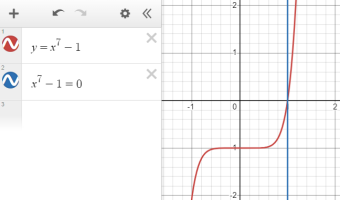Hi, I need help solving this equation exactly using only square roots. I'm aware that one solution for this problem is
[math]x_k=e^{\frac{2ki\pi}{7}}, k=0,1,...,6.[/math]
These roots are evenly partitioned as vertices in a regular heptagon in the complex plane. But this doesn't seem to help as I only obtained trigonometric solutions with this approach. I was given a hint by the author to define [imath]t=x+x^{-1}[/imath]. This was my attempt using that hint. Consider the following
[imath]x^7-1=(x-1)(x^6+x^5+x^4+x^3+x^2+x+1)=0.[/imath] Hence it would be enough to study the cyclotomic polynomial [imath]x^6+x^5+x^4+x^3+x^2+x+1[/imath]
By factoring out [imath]x^3[/imath] from this polynomial, we obtain the following expression
[math]x^6+x^5+x^4+x^3+x^2+x+1=x^3((x^3+x^{-3})+(x^2+x^{-2})+(x+x^{-1})+1)=0.[/math]
Given that [imath]t=x+x^{-1}[/imath], we have [imath]t^2=x^2+x^{-2}+2[/imath] and [imath]t^3=x^3+x^{-3}+3t.[/imath]. Hence
[math](x^3+x^{-3})+(x^2+x^{-2})+(x+x^{-1})+1=t^3+t^2-2t-1=0.[/math]Define [imath]t=y+\alpha[/imath]. Where [imath]\alpha=-1/3[/imath]. Then this polynomial reduces into [imath]y^3-\frac{7y}{3}-\frac{7}{27}=0.[/imath] Given that [imath]\Delta=(p/3)^3+(q/2)^2=-49/108<0[/imath]. The third-degree polynomial has three real roots. Set [imath]-\Delta =\Delta^{'}>0.[/imath]. Then the three roots are given by Cardanos formula, where
[math]\frac{-q}{2}+i\sqrt{\Delta^{'}} =\frac{7}{54}+\frac{7i}{6\sqrt3}=re^{i\phi}[/math]
Then by trigonometry, the angle [imath]\phi=arctan(3\sqrt3)[/imath]. Now it follows that [imath]y_j=\frac{2\sqrt7}{3}cos(\frac{\phi}{3}+\frac{2k\pi}{3})[/imath] for [imath]j=1,2,3[/imath] with corresponding values of [imath]k=0,1,2.[/imath]. Then you could conclude that [imath]t_1=y_1+\alpha, t_2=y_2+\alpha, t_3=y_3+\alpha[/imath]. But we already know that [imath]t=x+x^{-1}[/imath]. By multiplying by [imath]x[/imath], we get the quadratic equation [imath]x^2-tx+1=0[/imath], which by the quadratic formula gives the roots
[math]x=\frac{t\pm \sqrt{t^2-4}}{2}[/math]
By substitution of the three roots [imath]t_1,t_2[/imath] and [imath]t_3[/imath] into this expression, we obtain six possible roots as required. But this method only seemed harder and more complicated than the one above and does not yield any exact roots. The solution is still only an approximation. Can someone please help point me in the right direction. Thank you.
[math]x_k=e^{\frac{2ki\pi}{7}}, k=0,1,...,6.[/math]
These roots are evenly partitioned as vertices in a regular heptagon in the complex plane. But this doesn't seem to help as I only obtained trigonometric solutions with this approach. I was given a hint by the author to define [imath]t=x+x^{-1}[/imath]. This was my attempt using that hint. Consider the following
[imath]x^7-1=(x-1)(x^6+x^5+x^4+x^3+x^2+x+1)=0.[/imath] Hence it would be enough to study the cyclotomic polynomial [imath]x^6+x^5+x^4+x^3+x^2+x+1[/imath]
By factoring out [imath]x^3[/imath] from this polynomial, we obtain the following expression
[math]x^6+x^5+x^4+x^3+x^2+x+1=x^3((x^3+x^{-3})+(x^2+x^{-2})+(x+x^{-1})+1)=0.[/math]
Given that [imath]t=x+x^{-1}[/imath], we have [imath]t^2=x^2+x^{-2}+2[/imath] and [imath]t^3=x^3+x^{-3}+3t.[/imath]. Hence
[math](x^3+x^{-3})+(x^2+x^{-2})+(x+x^{-1})+1=t^3+t^2-2t-1=0.[/math]Define [imath]t=y+\alpha[/imath]. Where [imath]\alpha=-1/3[/imath]. Then this polynomial reduces into [imath]y^3-\frac{7y}{3}-\frac{7}{27}=0.[/imath] Given that [imath]\Delta=(p/3)^3+(q/2)^2=-49/108<0[/imath]. The third-degree polynomial has three real roots. Set [imath]-\Delta =\Delta^{'}>0.[/imath]. Then the three roots are given by Cardanos formula, where
[math]\frac{-q}{2}+i\sqrt{\Delta^{'}} =\frac{7}{54}+\frac{7i}{6\sqrt3}=re^{i\phi}[/math]
Then by trigonometry, the angle [imath]\phi=arctan(3\sqrt3)[/imath]. Now it follows that [imath]y_j=\frac{2\sqrt7}{3}cos(\frac{\phi}{3}+\frac{2k\pi}{3})[/imath] for [imath]j=1,2,3[/imath] with corresponding values of [imath]k=0,1,2.[/imath]. Then you could conclude that [imath]t_1=y_1+\alpha, t_2=y_2+\alpha, t_3=y_3+\alpha[/imath]. But we already know that [imath]t=x+x^{-1}[/imath]. By multiplying by [imath]x[/imath], we get the quadratic equation [imath]x^2-tx+1=0[/imath], which by the quadratic formula gives the roots
[math]x=\frac{t\pm \sqrt{t^2-4}}{2}[/math]
By substitution of the three roots [imath]t_1,t_2[/imath] and [imath]t_3[/imath] into this expression, we obtain six possible roots as required. But this method only seemed harder and more complicated than the one above and does not yield any exact roots. The solution is still only an approximation. Can someone please help point me in the right direction. Thank you.
Last edited:

